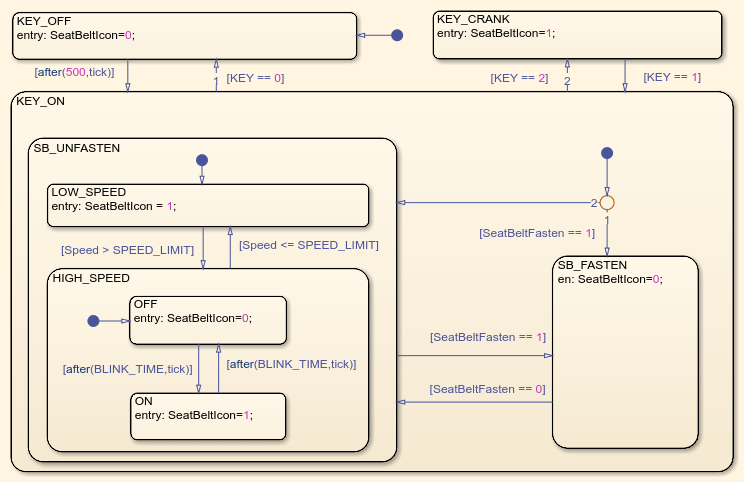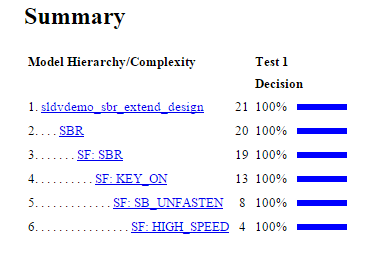Defining and Extending Existing Tests Cases
This example shows how Simulink® Design Verifier™ can extend test cases with additional time steps to efficiently generate complete test suites.
The example starts with a model containing time-delay characteristics that make test generation challenging. By creating a default test harness model and manually authoring one test, the critical obstacle to efficient test generation is removed. Simulink Design Verifier takes as input the logged values from the harness model and efficiently extends this test to create a complete test suite.
Model Characteristics That Motivate Test Case Extension
The sldvdemo_sbr_extend_design model includes the Stateflow® Chart SBR that uses temporal logic so that very long test cases are required to make a transition from the KEY_OFF state to the KEY_ON state. This type of time-delay characteristic is common in designs where a delay is used to reject spurious behavior or to wait for a physical system or user to respond. In this design, satisfying the temporal logic in this transition is a common obstacle to testing any of the states and transitions within the KEY_ON state.
This type of time-delay characteristic is usually easy to identify and satisfy with a manually authored test case.
open_system('sldvdemo_sbr_extend_design'); sf('Open',sldvdemo_ssid_to_sfid('sldvdemo_sbr_extend_design/SBR',11));

Creating a Harness Model and Defining Starting Tests
The Simulink Design Verifier function sldvmakeharness creates a harness model with a block that generates input values to the test model included by way of a Model block.
In this example, you specify a test case that keeps the system in the KEY_OFF state for 5 seconds:
[~, harnessModelFilePath] = sldvmakeharness('sldvdemo_sbr_extend_design',[],[],true); [~, harnessModel] = fileparts(harnessModelFilePath); sigEditorBlk = [harnessModel '/Inputs']; fileName = get_param(sigEditorBlk, 'FileName'); tcData = load(fileName); % Prepare a test case of length 5 seconds TemporalTestCase = tcData.TestCase_1; TemporalTestCase{1}.Values.Speed = timeseries(fi(zeros(2,1), 0, 16, 2), [0;5], 'Name', 'Speed'); TemporalTestCase{1}.Values.SeatBeltFasten = timeseries(false(2,1), [0;5], 'Name', 'SeatBeltFasten'); TemporalTestCase{1}.Values.KEY = timeseries(zeros(2,1,'int8'), [0;5], 'Name', 'SeatBeltFasten'); save(fileName, 'TemporalTestCase'); % Set TemporalTestCase as active scenario set_param(sigEditorBlk, 'ActiveScenario', 'TemporalTestCase');

Logging Starting Tests
In order to leverage the starting test case defined above, you use the sldvlogsignals function to capture the input values in the necessary logged data format.
The first input to sldvlogsignals is the path to a Model block, and the second input is the index of signal group(s) within the harness model. When you invoke sldvlogsignals, the parent model that contains the Model block is simulated.
The parent model is not restricted to Simulink Design Verifier harness models. Alternatively, you might log data from a closed-loop simulation model that uses a Model block to include the controller so that controller test cases more realistically reflect the continuous time behavior expected in the closed-loop system.
[~, modelBlock] = find_mdlrefs(harnessModel, false);
loggeddata = sldvlogsignals(modelBlock{1});
Extending Existing Tests During Test Generation
Before you can use existing test data during test generation, the data must be saved to a MAT-file. You enable test case extension in the Test Generation pane of the Simulink Design Verifier configuration parameters. Select Extend existing test cases, and specify the MAT file in the Data file field.
Generated tests either extend one of the starting test cases with one or more new time steps or will specify one or more time steps starting from the initial, or default, configuration.
save('existingtestcase.mat', 'loggeddata'); opts = sldvoptions; opts.ExtendExistingTests = 'on'; opts.ExistingTestFile = 'existingtestcase.mat'; opts.SaveHarnessModel = 'off'; opts.SaveReport = 'off'; [~, fileNames] = sldvrun('sldvdemo_sbr_extend_design', opts, true);
Verifying Complete Coverage
The sldvruntest function verifies that the new test suite achieves complete model coverage. The cvhtml (Simulink Coverage) function produces a coverage report that indicates 100% Decision coverage is achieved with the generated test vectors.
[~, finalCov] = sldvruntest('sldvdemo_sbr_extend_design', fileNames.DataFile, [], true); cvhtml('Final Coverage', finalCov);

Clean Up
To complete the demo, close all models and remove the saved logged data file.
close_system(harnessModel,0); close_system('sldvdemo_sbr_extend_design'); delete('existingtestcase.mat');